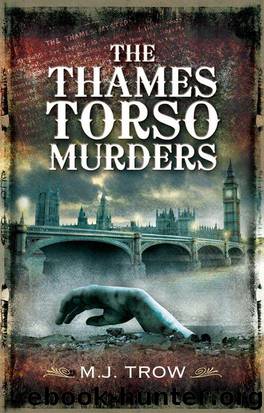The Thames Torso Murders by M.J. Trow

Author:M.J. Trow
Language: eng
Format: mobi
Publisher: Casemate Publishers
Published: 2012-08-23T22:00:00+00:00
Do clues still lie in that specially sealed box in the East London Cemetery, Plaistow, waiting for a more technologically advanced age … like ours?
Chapter 9
‘Dealers in Horror’: Battersea, 5 September 1873, and Putney, June 1874
The torso killings did not begin with Rainham in 1887, although they did end with Pinchin Street two years later. To find the start of this particular trail of terror, we have to go back fourteen years.
1873 was a year for deaths. In December, the first of the ‘London peculiars’, the thick fogs that enveloped the capital with sulphurous gloom, struck, killing an estimated 1,150 people in three days. On 1 May in the native village of Chitambo in what is Zambia today, the explorer and missionary David Livingstone was found dead in his hut, kneeling as if in prayer. A week later, in Avignon, France, the political campaigner and philosopher John Stuart Mill died of tuberculosis. His autobiography, published later in the year, heaped praise on his late wife, Harriet: ‘A real majestic intellect, not to say moral nature like yours, I can only look up to and admire.’
Not everybody was as eulogistic on womankind. At Durham, on 24 March, a dozen pressmen, a couple of medical students and a ghoul named Crooks who specialized in attending hangings, stood in the execution shed at the gaol to say a sorrowless farewell to the mass poisoner, Mary Ann Cotton. The hangmen were William Calcraft and Robert Evans, neither of them particularly efficient at their task and Mary Ann did not go quietly. According to her biographer, she was
swinging round, her chest heaving and her clasped hands jumping up and down. Then she began to twist about and to sway from side to side … Her body, unlike her mind, was loathe to give up life; it waged its desperate, frightful, hopeless fight. Shocked, hurt, in pain, it writhed, threw itself, jerked, the jumping hands frustrated by the pinioned arms from easing the agony of the cap and the rope, strangling mercilessly, inefficiently.1
And in September, another woman died. We still have no idea who she was.
With a rich irony, The Times featured a series on the Thames and its Embankment, a proud look at the extraordinary achievements of Joseph Bazalgette and the difference his engineering feat had made to London’s inhabitants. But right next to it, in the edition of 8 September, was a whole column and a half headed ‘Suspected Murder’. Three days earlier a Thames Police galley rowing routinely near Battersea saw an object floating in the river. It turned out to be the left quarter of a female torso. On 7 September two more portions were found, the right thigh floating off Woolwich and the right shoulder, with part of the arm attached, off Greenwich. The police noticed and subsequent medical reports confirmed that the arm was smeared in tar which probably occurred as the limb bobbed downstream, colliding with mooring ropes and other debris. The Times commented that the Woolwich find was
Download
This site does not store any files on its server. We only index and link to content provided by other sites. Please contact the content providers to delete copyright contents if any and email us, we'll remove relevant links or contents immediately.
Mindhunter: Inside the FBI's Elite Serial Crime Unit by John E. Douglas & Mark Olshaker(9137)
Wiseguy by Nicholas Pileggi(5627)
Hitman by Howie Carr(4994)
Room 212 by Kate Stewart(4991)
Secrecy World by Jake Bernstein(4611)
Killers of the Flower Moon: The Osage Murders and the Birth of the FBI by David Grann(4363)
Papillon (English) by Henri Charrière(4167)
Breaking Free by Rachel Jeffs(4135)
Killers of the Flower Moon by David Grann(3922)
Say Nothing by Patrick Radden Keefe(3864)
American Kingpin by Nick Bilton(3731)
The Secret Barrister by The Secret Barrister(3589)
Molly's Game: From Hollywood's Elite to Wall Street's Billionaire Boys Club, My High-Stakes Adventure in the World of Underground Poker by Molly Bloom(3461)
Mysteries by Colin Wilson(3376)
In Cold Blood by Truman Capote(3284)
Signature in the Cell: DNA and the Evidence for Intelligent Design by Stephen C. Meyer(3022)
I'll Be Gone in the Dark by Michelle McNamara(2998)
Rogue Trader by Leeson Nick(2955)
Bunk by Kevin Young(2917)
